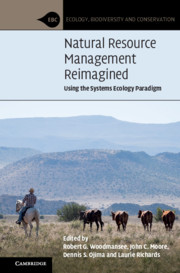Book contents
- Natural Resource Management Reimagined
- Ecology, Biodiversity and Conservation
- Natural Resource Management Reimagined
- Copyright page
- Contents
- Contributors
- Preface
- 1 The Systems Ecology Paradigm
- 2 Environmental and Natural Resource Challenges in the Twenty-First Century
- 3 Evolution of Ecosystem Science to Advance Science and Society in the Twenty-First Century
- 4 Five Decades of Modeling Supporting the Systems Ecology Paradigm
- 5 Advances in Technology Supporting the Systems Ecology Paradigm
- 6 Emergence of Cross-Scale Structural and Functional Processes in Ecosystem Science
- 7 Evolution of the Systems Ecology Paradigm in Managing Ecosystems
- 8 Land/Atmosphere/Water Interactions
- 9 Humans in Ecosystems
- 10 A Systems Ecology Approach for Community-Based Decision Making
- 11 Environmental Literacy
- 12 Organizational and Administrative Challenges and Innovations
- 13 Where to From Here? Unraveling Wicked Problems
- Index
- References
3 - Evolution of Ecosystem Science to Advance Science and Society in the Twenty-First Century
Published online by Cambridge University Press: 25 February 2021
- Natural Resource Management Reimagined
- Ecology, Biodiversity and Conservation
- Natural Resource Management Reimagined
- Copyright page
- Contents
- Contributors
- Preface
- 1 The Systems Ecology Paradigm
- 2 Environmental and Natural Resource Challenges in the Twenty-First Century
- 3 Evolution of Ecosystem Science to Advance Science and Society in the Twenty-First Century
- 4 Five Decades of Modeling Supporting the Systems Ecology Paradigm
- 5 Advances in Technology Supporting the Systems Ecology Paradigm
- 6 Emergence of Cross-Scale Structural and Functional Processes in Ecosystem Science
- 7 Evolution of the Systems Ecology Paradigm in Managing Ecosystems
- 8 Land/Atmosphere/Water Interactions
- 9 Humans in Ecosystems
- 10 A Systems Ecology Approach for Community-Based Decision Making
- 11 Environmental Literacy
- 12 Organizational and Administrative Challenges and Innovations
- 13 Where to From Here? Unraveling Wicked Problems
- Index
- References
Summary
“Leaders stand on the shoulders of those who came before them” (paraphrased from Bernard of Chartres and Isaac Newton among others) and they depend on those around them to hold them up. The evolution of ecosystem science is traced in this chapter from its conceptual beginnings in the late 1500s (and earlier) until now. The importance of “giants” in soil science, botany, chemistry, zoology, and microbiology in establishing the scientific basis for what later would become “ecology” and later yet “ecosystem science” is emphasized. As the science evolved toward the study of the structure and functioning of ecosystems, relying heavily on the systems ecology paradigm and especially as humans became recognized as integral parts thereof, research philosophy and methodology needed to change. Science needed to evolve from individual scientists (giants) with reductionist perspectives to transdisciplinary and interdisciplinary teams of scientists with leaders (often multiple leaders) having holistic, systems thinking perspectives buttressed by cadres of collaborators and technical and administrative supporters, often from many locations nationally and internationally. Now teams are beginning to include social sciences, economists, education and engagement specialists, managers, decision-makers, and other stakeholders.
Keywords
- Type
- Chapter
- Information
- Natural Resource Management ReimaginedUsing the Systems Ecology Paradigm, pp. 66 - 89Publisher: Cambridge University PressPrint publication year: 2021



